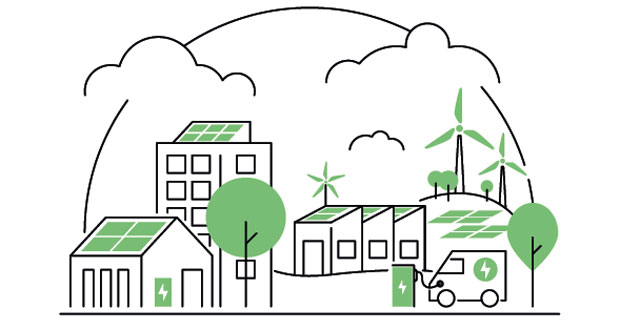 THE ARCHITECT’S VIEW
THE ARCHITECT’S VIEW
MITAKSHI SIRSI,
DIRECTOR OF SUSTAINABILITY, BROADWAY MALYAN
Sustainable building rent ‘premiums’ have been discussed for different reasons over the past decade, from being tied to higher costs to certification FOMO. While the question persists, the underlying reasons have shifted – for example, the cost misconception has been explained (for the most part). Some might say it is semantics – but I still find the use of the term “sustainable buildings” problematic. I suggest we call them better buildings because calling them sustainable just reflects the industry’s siloed approach to sustainability.
Let’s ask the question differently, then. We understand now that buildings can be made better and provide increased value without significant cost. How should the connection between rents, sustainable (aka better) buildings, and offices figure in the larger picture of why we need to address their environmental impact?
Also consider recent changes. The pandemic was a shock to workplaces and city centres in the western world, reacting in unprecedented ways. Analysts believe that the existing rigid typology is going to get diluted in most urban centres now. This also coincides with increased awareness and new carbon related best practices being demanded from buildings. More is being expected from our industry from all sides, and we are still figuring out how to deliver this.
The premium concept hinges on value. How much does a company value its workplace? A company’s shifting priorities post-pandemic are underlined by the values they embrace, and many anticipate a lasting, if not permanent, shift. Broadly speaking, companies now desire compact spaces with ample daylight, enhanced collaboration zones, flexibility, reduced energy expenses, intelligent technology, improved indoor air quality, and ventilation. This alignment is both smart for business and in response to a workforce seeking better spaces.
However, does this equate to a desire to design and commission more sustainable buildings? Not explicitly. “Sustainable” buildings generally embody the above traits, yes, but that does not work the other way round. Buildings that have these traits may still create a negative impact on the environment.
We live in a world where the cost of real estate remains a big concern. This means some can afford better space than others, which is a positive if it opens pathways to innovation in the said space. However, disparities in affordability must not halt action on the climate crisis. Adopting market driven initiatives as the norm and in regulations can revitalise structures, level the playing field and drive the necessary changes we need. Let’s harness these – better sustainability regulations especially in retrofitting, will certainly help breathe life into our most inefficient buildings at scale.
While I applaud rent premiums for sustainable buildings, its flip side creates exclusivity. Standardising sustainability requirements create opportunities for loopholes and bureaucratic funk. So, are there no solutions here?
I would like to believe that all the above solutions combined with others such as upskilling technical abilities, behavioural change measures, education and more integrated working with less siloed approaches between industry professionals can make a huge difference.
Let’s not choose between solutions – let’s do “all of the above”, and more.
 BUILDING SERVICES AND MAINTENANCE PROVIDER’S VIEW
BUILDING SERVICES AND MAINTENANCE PROVIDER’S VIEW
STEVE MCGREGOR,
GROUP MANAGING DIRECTOR, DMA GROUP
It’s predicted that 80 per cent of the buildings that exist today will still be standing come 2050. We need to accept the fact that almost every existing building will need to be adapted if the UK is to meet net zero targets.
There are many ways to reduce the carbon footprint of a building, but it should always start with reducing energy demand. For example, improved roof and wall insulation, double and even triple glazing, better lighting, or more efficient M&E maintenance. Once those efficiency improvements are made the building consumption has been optimised, so considering renewables then becomes more appropriate.
Making these adaptations can be tough in any building but become much more challenging and complicated in historical buildings that weren’t designed with modern technologies and working practices in mind. Reducing the carbon footprint of heritage buildings is a greater challenge, and potentially more expensive, but the environmental need to do so remains critically important.
With a reduction in demand, there are of course immediate energy savings to be had. But there are drawbacks. Firstly, an organisation needs to know where to start. For some, deploying green initiatives can seem daunting despite the long-term environmental benefits they bring. They need guidance on the right methods that best suit them, and to do this they need to invest in an energy audit to prioritise what to do and how to do it.
Of course, deploying renewables drives us towards net zero carbon and a better, healthier environment for us all. However, we can’t be naïve. The capital costs involved in replacing a conventional gas boiler with a heat pump are huge by comparison. Even with a government grant, the cost of a heat pump is typically twice that of a conventional gas boiler. Not to mention the very long lead times to buy and install this renewable technology. These challenges are magnified by the exceptional macro-economic and geo-political events that currently conspire to compound our net zero objectives.
More energy efficient buildings become a premium and as a result, sell quicker. And in new buildings it’s a lot easier to deploy green initiatives than repurposing our existing stock. When it comes to attracting rent premiums for enhanced sustainability attributes, there is the advantage of incentivising property owners to invest in sustainability features, which could drive faster adoption. On the flip side, this may create social and economic inequalities, with only big companies being able to afford sustainable office space, while excluding smaller businesses.
However, by establishing a minimum standard in sustainability, environmentally friendly spaces would be more evenly distributed, preventing a scenario where only those who could afford premium rents could access sustainable workplaces.
Standard requirements would likely lead to more widespread and lasting changes in the built environment, contributing to larger-scale reductions in energy consumption and carbon emissions. Having clear, mandatory standards would make it easier for companies to evaluate potential office spaces based on sustainability criteria. This could also drive competition among building owners to meet and exceed these requirements. The challenges here are the costs which could lead to resistance from property owners and developers and could still make sustainable workplaces unaffordable.





